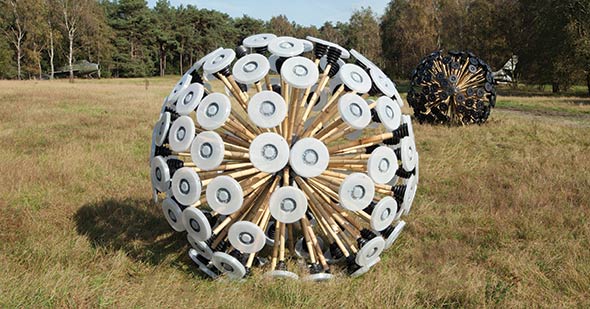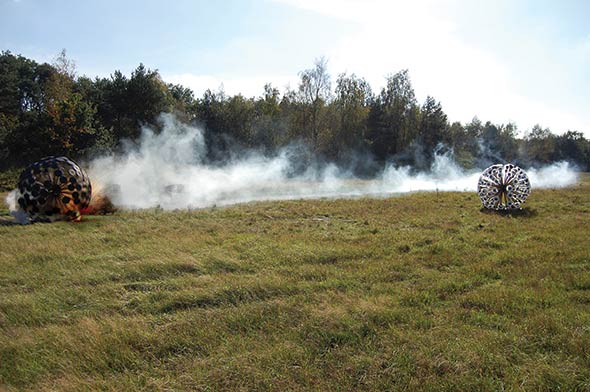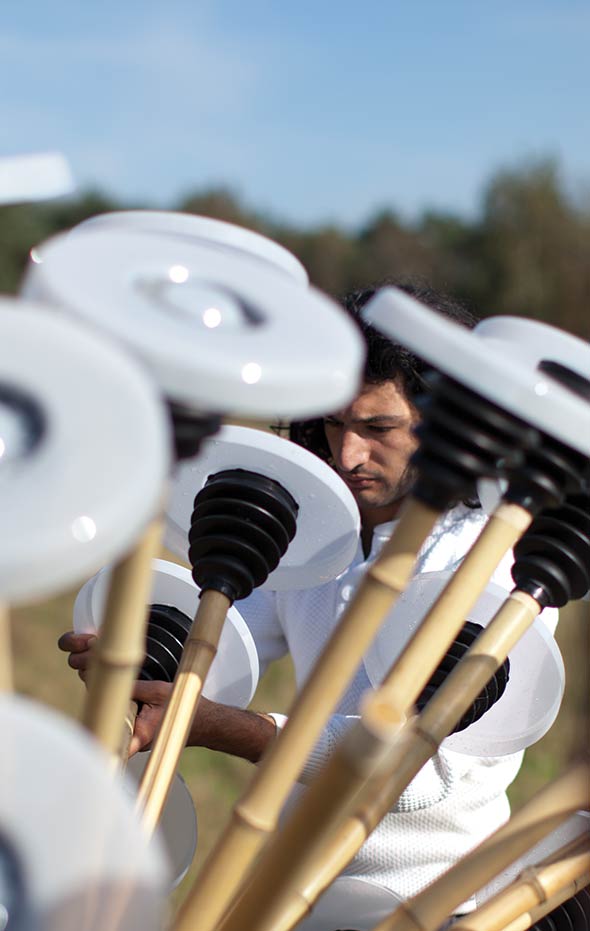Afghani designer Massoud Hassani takes the idea of a childhood toy and transforms it into a device that will save lives. Design adopts a heroic identity in this clean, simple, and efficient project



If you ever played with a suction cup ball as a child, most likely it was an utterly unremarkable experience. Rubbery, fluorescent, and dirty, this toy was probably most often found as a cheap party favor or classroom knick-knack, something to play with once and then toss away, a cluster of acrylic bowls standing on flimsy stems reaching out from a cheap plastic center. Something that would probably be found later wedged behind the couch or stuck under the refrigerator.
But where others saw these objects as worthless, Massoud Hassani saw potential in them. Earlier this year, Hassani, a recent graduate of Design Academy Eindhoven in the Netherlands, turned the spindly starburst shape into nothing short of a miracle worker. His creation, Mine Kafon, would not be out of place in a sculpture garden, but Hassani, 27, built it with thoughts of his native Afghanistan.
Growing up in Kabul, Hassani was no stranger to instruments of destruction.
“[At a] young age we learned to make our own toys. One of my favorite toys was a small rolling object. It was powered by the wind,” he writes on his website. But frequently, those homemade trinkets would be blown onto forbidden patches of land. Decades of invading and occupying armies transformed Afghanistan’s rolling plateaus into some of the world’s deadliest minefields. “It was full of them. I still remember those friends that we have lost and saw them getting injured,” Hassani writes. Today, minesweeping efforts abound from Afghanistan to sub-Saharan Africa to Central America. Metal detection technology has advanced, and mine-clearing teams often include highly trained service animals and armored bulldozers. But even with the latest technology, it remains a sensory affair.But it doesn’t have to be, Hassani argues with his creation. It can be as simple as the device he created.
“I re-made one of those objects, 20 times bigger, heavier, and stronger. It is powered by the wind, and it’s meant for the same areas [that] were full of land mines,” Hassani explains.
Mine Kafon’s aesthetic is reminiscent of an Apple product—clean, simple design with the capability for wonders beneath its surface. A nest of bamboo stalks is rooted to a black box and topped with a flat disc of biodegradable plastic. It instantly recalls the imagery of those discarded suction cup balls, but unlike those mass-produced baubles, Mine Kafon is not intended to stay in one place.
Placed on the edge of a minefield, Hassani’s construction waits for a breeze to push it across the explosive terrain. When one of its plates grazes a mine… boom! Two or three of its legs are lost in the detonation, but Mine Kafon keeps rolling until its limbs are exhausted or the wind dies down. A GPS device embedded in the hull allows peacekeeping forces to record the progress.
Alluring as it is, this solution will take a much larger scale of production for Mine Kafon to compete with the industrial standards currently used by mine-removal teams. The International Campaign to Ban Landmines estimates there are anywhere between 52,000 and 60,000 mines and other explosive devices still blanketing Afghanistan. The rugged country had hundreds of thousands of the brutal devices after a quarter-century of invasions from the Soviet Union, Taliban, and the United States. Progress has been made, but there’s still a long way to go.
And the mines themselves aren’t the only things a device like Mine Kafon is up against. Insurgent groups that utilize ground-based explosives go to great lengths to protect their minefields. In July, at least four minesweepers working for a local non-governmental organization, the Demining Agency for Afghanistan, were killed after being abducted along with 28 colleagues. And globally, there may be as many as 270 million mines lurking in the soil.
Léopold Lambert, an architect in New York, wrote recently on his blog that Hassani’s device has “a violence within it” and that as an object, “it does not take much to think of [it] as an autonomous being.”
It’s easy to agree with both statements. Since unveiling Mine Kafon, Hassani has been enlisted by the Dutch army for field tests. If they’re successful, perhaps one day we will see former killing fields dotted with these multi-limbed spheres splintering apart as they eradicate rows of mines. It is likely that Hassani would have to replenish the efforts, but what an intricately designed way to heal the world.
TEXT BY Benjamin Freed
PHOTOGRAPHY BY Jeroen van Oirschot

